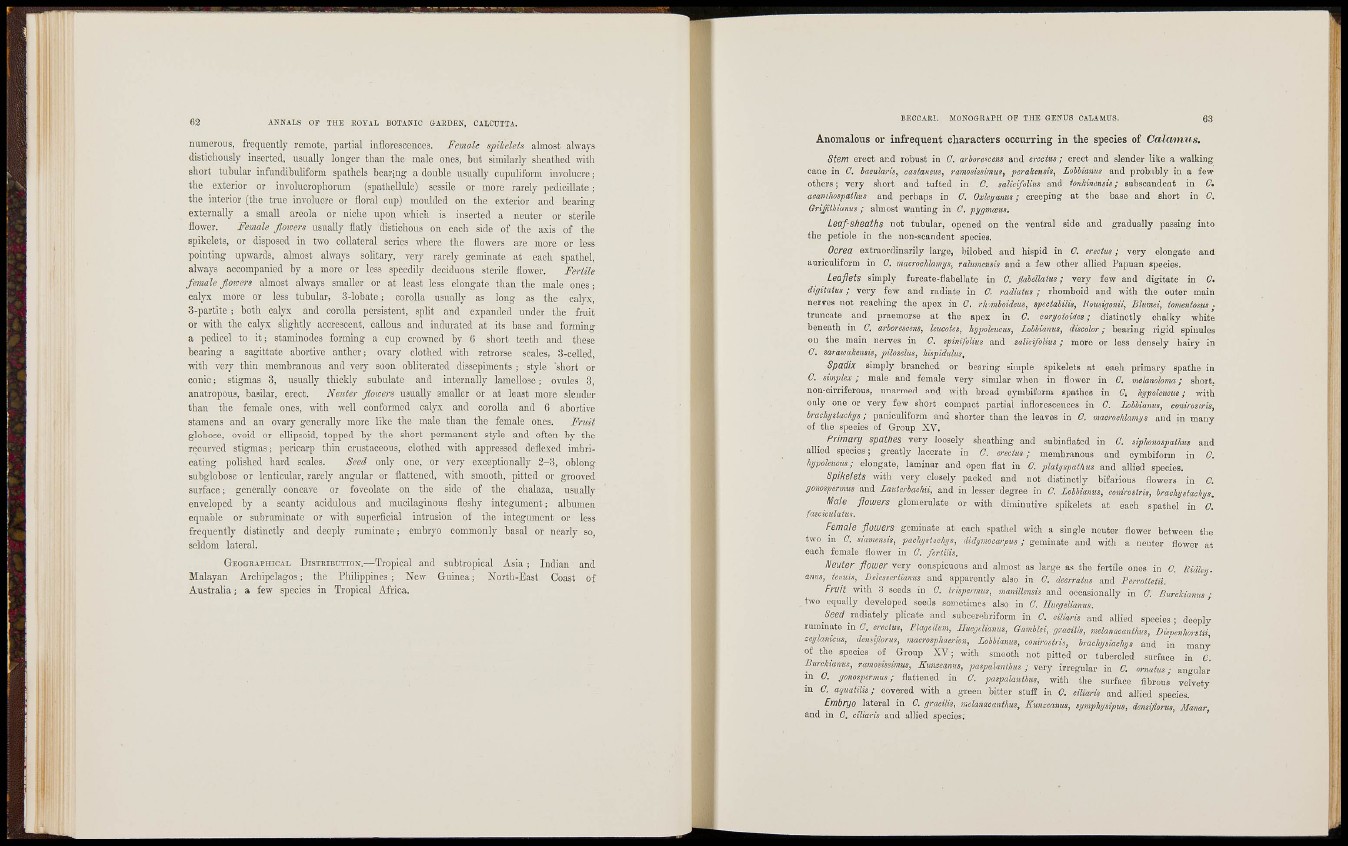
62 ANNALS OP THE EOTAL BOTANIC GAEDEN, CALCUTTA.
numerous, frcquentlj" remote, partial infloresceaces. Female spihelets almost alwaj^s
disticliously inserted, usually longer than the male ones, but similarly sheathed with
short tabulai infundibuliform spathels bearing a doable usually cupuliform involucre ;
the exterior or involucrophorum (spatliellule) sessile or more rarely pcdicillate ;
the interior (the true involucre or floral cup) moulded on the exterior and bearing
externally a small areola or niche upon \vhich is inserted a neuter or sterile
ñower. Female flowers usually flatly distichous on each side of the axis of the
spikelets, or disposed in two collateral series M^here the flowers arc more or less
pointing upwards, almost always solitary, very rarely geminate at each spathel,
alwaj-s accompanied by a more or less speedily deciduous sterile flower. Fertile
female floicers almost always smaller or at least less elongate than the male ones ;
calyx more or less tubular, 3-lobate ; corolla usually as long as the calyx,
3-partite ; both calyx and corolla persistent, split and expanded under the fruit
or with the calyx slightly accrescent, callous and indurated at its base and formin"-
a pedicel to it; staminodes forming a cup crowned by 6 short teeth and these
bearing a sagittate abortive anther; ovary clothed -with retrorse scales, 3-celled,
•with very thin membranous and very soon obliterated dissepiments ; style short or
conic; stigmas 3, usually thickly subulate and internally lamellose ; ovules 3,
anacropous, basilar, erect. Neuter fl,owers usually smaller or at least more slender
than the female ones, with well conformed calyx and corolla and 6 abortive
stamens and an ovary generally more like the male than the female ones. Fruit
globose, ovoid or ellipsoid, topped by the short permanent style and often by the
recurved stigmas; pericarp thin crustaceous, clothed with appressed deflexed imbricating
polished hard scales. Seed only one, or very exceptionally 2-3, oblong
subglobose or lenticular, rarely angiüar or flattened, with smooth, pitted or grooved
surface; generally concave or foveolate on the side of the chalaza, usually
enveloped by a scanty acidulous and mucilaginous fleshy integument ; albumen
ec|uable or subruminate or -nith superficial intrusion oí the integument or less
frequently distinctly and deeply ruminate ; embryo commonly basal or nearly so,
seldom lateral.
GEOGR.vinic.vi, DISTEIBUTIOX.—Tropical and subtropical Asia ; Indian and
Malayan Archipelagos ; the Philippines ; New Guinea ; North-East Coast of
Austraha ; a few species in Tropical Africa.
BECOAJU. MONOGKAPH OF THE GENUS CALAMUS,
Anomalous or i n f r e q u e n t c h a r a c t e r s occurring i n tlie species of Calmnns,
Stem erect ai:d robust in C. arborexcens and crcciua; erect aud slender like a walking
cane in C. baoularis, eastmeiis, ramosissimus, perahensis, Lobliams and probably ia a few
others; very short and tufted in C. salicifolius and ionkinensis; subscandent in C.
ar.awhospathiis and perhaps in C. Oxlcyanus; creeping at tlie base and short in C,
Griffithwnus ; almost wanting in C. pygmceua.
Leaf-sheaths not tubular, opened on the ventral side and gradually passing into
the petiole in the non-scandent species.
Oorea extraordinarily large, bilobed aud hispid in 0. ercctus; very elongate and
auriculiforiT) in C. macroclilami/s. ralumenm and a few other allied Papuan species.
Leaflets simply furcate-flabellate in C. Jlabellatus; very few and digitate in C,
digitaius; very few and radiate in C. radiaius ; rhomboid and with tho outer main
neryes not reaoliing the apex in C. rh.mhoideiis, speciaUlis, l^ousigonii, Bktmei, iomentosm •
truncate and praemorse at the apex in 0. caryoioidas; distinctly chalky white
beneath in C. arhorescorts, leiiootes, hijiioleucus, Lobhianus, discolor; beaiing rigid spiuules
on the main nerves in C. spinifoiius and salicifoUus; more or less densely hairy in
C. saraivakensts, jnloselus, hispidtilus,
Spadix simply branched or bearing simple spikelets at eaeh primary spathe in
C. simplex; male and female very similar when in flnvver in 0. melanoloma; short,
uon-cirriferous, unarmed and with broad oymbiform spathes in C. hypoleuciis; with
only one or very few short compact partial inflorescences in 0. Lobhianus, conirosiris,
braehystaehys; paniculiform and shorter than the leaves in 0. macrochlamn^ and in many
of the species of Group XV.
Primary spathes very loosely sheathing and subinflated in C. iiphonospai/ms and
allied species; greatly lacerate in C. erectus; membranous and cymbiform in 0.
hypolmcus; elongate, laminar aud open flat in 0. platyspathus and allied species.
Spikelets with very closely packed and not distinctly bifarious flowers in 0.
Sotmpermm and Luuterbadm, and in lesser degree in C. LoUiantu, cmiroitH,, tmcbjstadnjs.
Male flomers glomerulate or with diniinraive spikelets at eaeh spathel in 0.
fasciciilaiua.
Female fmers geminate at each spathel with a single neuter flower between the
two in C. iiamam, fachjiUehns, clliimosarpm; geminate and with a neuter gower at
each female flower in C. fortilis.
Neuter flower very conspicuons and almost as large as the fertile ones in 0. liidk^j.
mas, ienim, DeUsseriianus and apparently also in C. dserratus and Perroitetii.
Fruit with 3 seeds in 0. triufcrmus, mauilkmit and occasionally in C. Burckimm;
two equally developed seeds sometimes also in C. Ilucgelianus,
Seed radiately plicate and snbcorobriform in 0. kiarh and allied species • deeply
raminate m 0. ermtm, Fla,jdU,m, Mmsdimm, Oamblci, ¡¡vaciH,, ,mlunaaantk„i, Diamhm-sUi
:,Hlamcm, clemijlon', macrosfluerion, LoUanm, conirostn,, Iradnjsiachiii, and in many
of tho species of Gronp XV; with smooth not pitted or tabercled surface in C
Burckmr.m, ramomrimm, Kunzeanu,, pasp^hnUm,; very irregular in 0. crnatu, • angular
in C. sono,f„;nu,; flattened in G. fa,falanibm, with the surface fibrous velvety
m 0. aquatiih; covered with a green bitter stnfl in C. dUaris and allied species.
Embryo lateral in 0. graciHs, melamcantim, Kmseanus, sympktjaipus, densiflorm Mamr
and in 0. dUaris and allied species: ' '